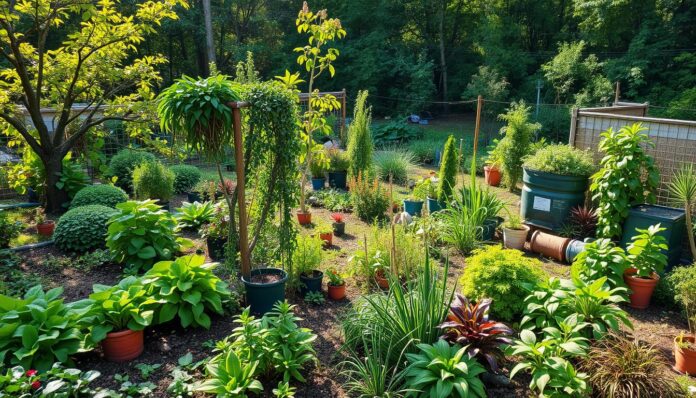Imagine a food system that not only grows healthy food but also recovers resources and cuts down on waste. Permaculture, a green farming method, makes this dream a reality. It turns food production into a closed loop, where everything is reused, helping the environment.
By using permaculture, we can lessen waste and save energy. This is key for keeping our planet healthy. For example, trees in dry areas can make the soil better by providing shade. This helps keep water in the ground, which is good for both farming and the environment.
Key Takeaways
- Permaculture is a green farming way that helps both people and the planet, supporting resource recovery.
- Permaculture systems can recover resources, reduce waste, and promote environmental sustainability, which is crucial for waste management and sustainable agriculture.
- Agroforestry and permaculture systems can contribute to soil improvement, watershed protection, carbon sequestration, and biodiversity, supporting permaculture resource recovery and sustainable agriculture.
- Permaculture principles can be applied to reduce waste, conserve energy, and promote environmental sustainability, which is essential for waste management and sustainable agriculture.
- Permaculture resource recovery and sustainable agriculture can help mitigate climate change by sequestering carbon dioxide and promoting ecosystem services, supporting waste management and sustainable agriculture.
Introduction to Permaculture and Resource Recovery
Permaculture is a way to farm that looks at how plants, animals, and tiny life forms interact. It aims to make a system that is good for the planet and doesn’t waste much. This helps keep our environment healthy and supports environmental sustainability.
By using organic farming methods, people can lessen their harm to the environment. This also helps keep ecosystems balanced and strong.
Definition of Permaculture
Permaculture is about designing and caring for farms that work like nature. It focuses on regenerative design to use what’s available and not need much from outside.
Importance of Resource Recovery
Getting resources back is key in permaculture. It helps cut down on waste and keeps ecosystems healthy. By doing this, people can lessen their impact on the planet and support environmental sustainability.
Core Principles of Permaculture
The main ideas of permaculture are to have diversity, use what’s available, and not need much from outside. These ideas help make a system that’s good for the planet. They are connected to organic farming and regenerative design.
Identifying Resources in Permaculture
Permaculture systems use various resources to create a circular economy. This helps improve soil health and cuts down on waste. Knowing about different resources lets people design and use sustainable practices. Green technology is also key in making these systems more efficient and less reliant on non-renewable resources.
Some important resources in permaculture include:
- Natural resources, like sunlight, water, and soil
- Tools, infrastructure, and knowledge made by humans
- Plants and animals, vital for permaculture systems
Effective management of these resources leads to a sustainable and regenerative system. This system boosts soil health and biodiversity. Using circular economy principles helps reduce waste and environmental impact. Green technology also improves resource use and supports sustainable growth.
| Resource | Benefits |
|---|---|
| Natural Resources | Promote soil health, reduce waste, and minimize environmental impact |
| Human-made Resources | Enhance resource efficiency, reduce dependence on non-renewable resources, and promote sustainable development |
| Biological Resources | Promote biodiversity, enhance ecosystem services, and support regenerative agriculture |
By understanding and managing these resources well, people can build a sustainable permaculture system. This system supports soil health, biodiversity, and circular economy principles.
Soil Health and Resource Recovery
Soil health is key in permaculture systems. Keeping it healthy is vital for sustainable farming. Eco-friendly methods like composting and mulching help a lot. They save soil, cut down waste, and make soil richer.
Good waste management is also important for soil health. Composting and mulching are great for this. They lessen waste and boost soil fertility. Practices like crop rotation and cover cropping also help. They make soil better and cut down on harmful chemicals.
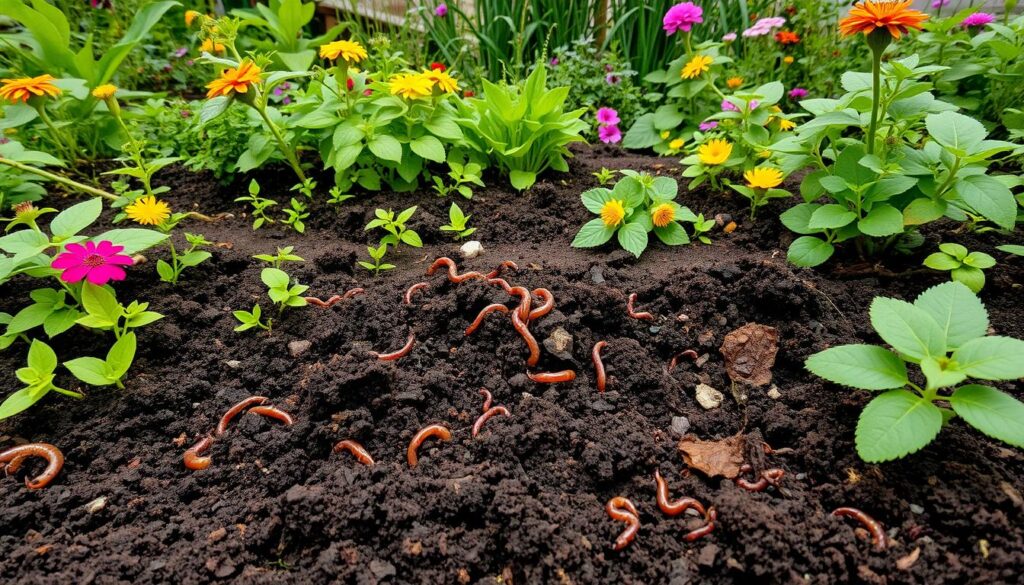
- Improved soil health and fertility
- Increased crop yields
- Reduced water pollution
- Greater biodiversity
Using these green practices and smart waste management helps a lot. It makes farming better for the planet. It also reduces the harm caused by old farming ways.
| Practice | Benefits |
|---|---|
| Composting | Reduces waste, promotes soil fertility |
| Mulching | Conserves soil moisture, suppresses weeds |
| Crop rotation | Improves soil health, reduces pest and disease pressure |
Water Conservation Techniques
Water is very precious, and saving it is key in permaculture. Only a small part of the world’s water is safe for us to use. It’s important to use water wisely and not waste it. Permaculture helps by finding ways to use water again and again.
Using a regenerative design helps make a system where water is saved. This can be done through rainwater harvesting, greywater systems, and swales and contour plowing. For example, collecting rainwater can greatly reduce water use and costs, helping during dry times.
Rainwater Harvesting
Rainwater harvesting is a simple way to collect and store rainwater. It’s used for things like watering plants and flushing toilets. This method helps lower the need for city water and cuts down on stormwater runoff.
Greywater Systems
Greywater systems use wastewater from sinks, showers, and washing machines for irrigation and other uses. It helps cut down on wastewater and supports a circular economy.
Swales and Contour Plowing
Swales and contour plowing manage water flow and stop erosion. Swales are shallow ditches that follow the land’s shape, letting water soak into the soil. This method helps keep water in the ground and recharge it, making the design more regenerative.
Using these water-saving techniques can lessen our environmental impact. It helps create a sustainable water system. This is good for the planet and supports permaculture’s goals of using resources wisely.
| Technique | Benefits |
|---|---|
| Rainwater Harvesting | Reduces demand on municipal water supplies, decreases stormwater runoff |
| Greywater Systems | Reduces wastewater generation, creates a more circular economy |
| Swales and Contour Plowing | Boosts water retention, recharges groundwater, prevents erosion |
Energy Efficiency in Permaculture
Energy efficiency is key in permaculture. It helps lower the environmental impact of farming. By using green technology and environmental sustainability, we can cut down our carbon footprint. Renewable energy like solar and wind power is a big part of this.
Organic farming also plays a role. Using compost and manure as fertilizers cuts down on synthetic fertilizer use. This saves a lot of energy. Plus, saving rainwater helps use less energy too.
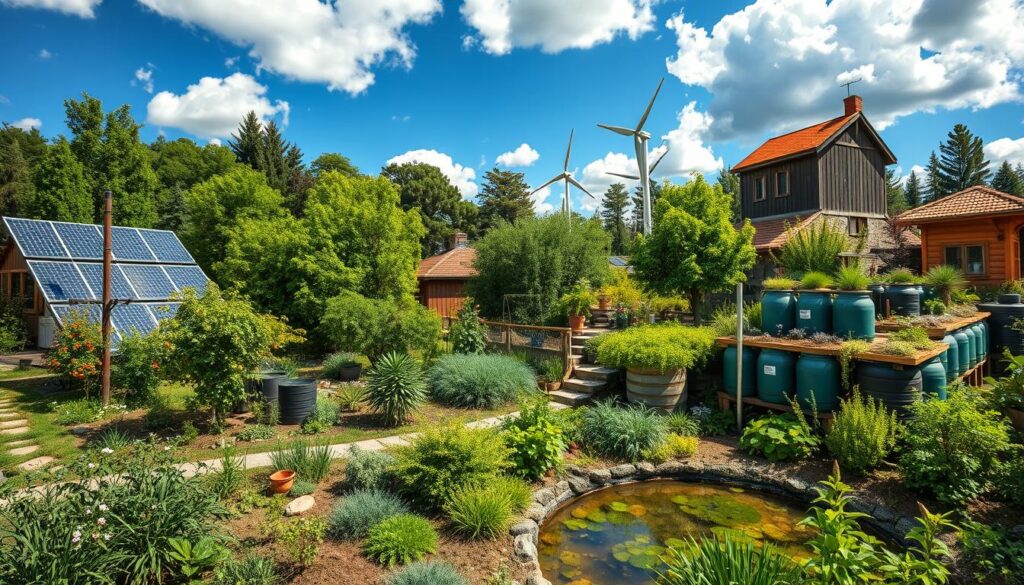
Energy efficiency in permaculture brings many benefits. These include:
- Less energy use
- Lower greenhouse gas emissions
- Healthier soil
- Bigger crop yields
By following these steps, we support environmental sustainability. We also lessen our need for non-renewable energy. This helps make our food system more sustainable.
Waste Management Strategies
Effective waste management is key for sustainable agriculture. It helps lessen the environmental harm from farming. Eco-friendly practices like composting and recycling cut down waste and support sustainable farming. Strategies like organic waste recovery, recycling, and upcycling are vital for a green system.
Some important waste management strategies include:
- Composting, which cuts down landfill waste and lowers methane emissions
- Recycling, which can save 40-80% energy compared to making new materials
- Upcycling, which can cut landfill waste by about 20%
Using these strategies, people can lessen their environmental footprint. For instance, vermicomposting is a fast way to process food waste, making nutrient-rich worm castings good for urban gardens. Also, community composting helps manage extra organic waste and encourages green practices among neighbors in cities.
| Waste Management Strategy | Environmental Benefit |
|---|---|
| Composting | Reduces landfill waste and decreases methane emissions |
| Recycling | Reduces energy consumption by 40-80% compared to producing new materials |
| Upcycling | Leads to a reduction in landfill contributions by approximately 20% |
Utilizing Climate and Topography
Permaculture is all about working with nature’s climate and land shape. It follows regenerative design to create a sustainable cycle. This way, it reduces harm to the environment and boosts resilience.
Microclimates are very important for saving resources. They can make plants grow longer or protect them from harsh weather. Also, how land slopes and drains water is key to managing water well, avoiding floods and landslides.
Microclimates for Resource Efficiency
Creating microclimates needs careful planning and watching the landscape. It involves using natural or added features to change temperature, humidity, and wind. This boosts biodiversity and makes systems more productive.
Elevation and Drainage Strategies
Elevation and drainage are vital in permaculture, mainly in flood or landslide areas. Good management of these can reduce risks from extreme weather. This is where regenerative design and circular economy come in, aiming for a cycle of resource use to cut waste and boost efficiency.
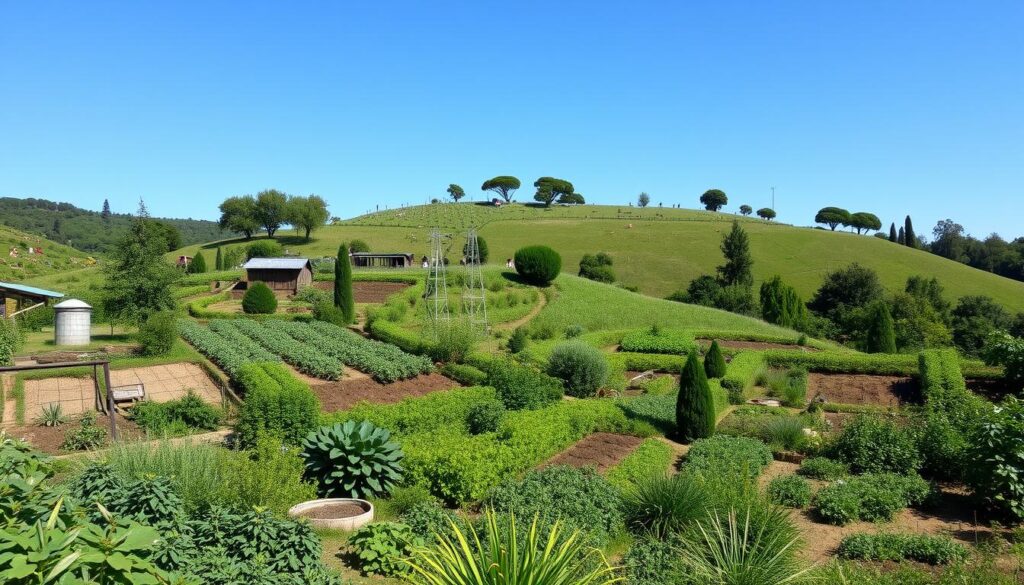
Windbreaks and Shelterbelts
Windbreaks and shelterbelts protect crops and soil from wind damage. They also help create microclimates, making systems more resilient. By adding these to their design, people can create a balanced and thriving ecosystem, following permaculture’s principles.
Biodiversity and Resilience
Permaculture focuses on biodiversity to boost environmental health and soil quality. It encourages a variety of plants and animals. This way, permaculture creates strong ecosystems that grow well with little outside help.
Some key benefits of biodiversity in permaculture include:
- Soil health gets better with more organic matter and nutrient cycling
- Ecosystem services like pollination and pest control improve
- Systems become more resilient against stressors like drought and disease
Methods like companion planting and permaculture guilds help increase biodiversity. For instance, marigolds with tomatoes can fight nematodes. Comfrey with vegetables attracts good insects.
Using these methods, people can build permaculture systems that focus on sustainability, organic farming, and soil health. This helps make our food system more resilient and diverse.
| Benefit | Description |
|---|---|
| Soil Carbon Sequestration | Permaculture systems can sequester up to 71% more soil organic carbon than conventional farming systems |
| Biodiversity | Permaculture systems can support up to 457% more species richness than conventional farming systems |
| Resilience | Permaculture systems can improve resilience to environmental stressors, such as drought and disease, by up to 201% |
Ethical Land Management Practices
Using eco-friendly practices in land management is key to a healthy environment. Sustainable agriculture helps by reducing waste and farming’s environmental impact. Agroforestry, which mixes trees with crops, boosts biodiversity and fights soil erosion.
Waste management is also vital in ethical land use. Regenerative agriculture helps by improving soil health and supporting ecosystems. This approach lowers a farm’s environmental impact, supporting sustainable farming.
Benefits of these practices include:
- Improved soil health
- Increased biodiversity
- Reduced waste and pollution
- Promotion of sustainable agriculture
Farmers can make a big difference by using eco-friendly methods. Techniques like agroforestry and regenerative agriculture help. They also manage waste well.
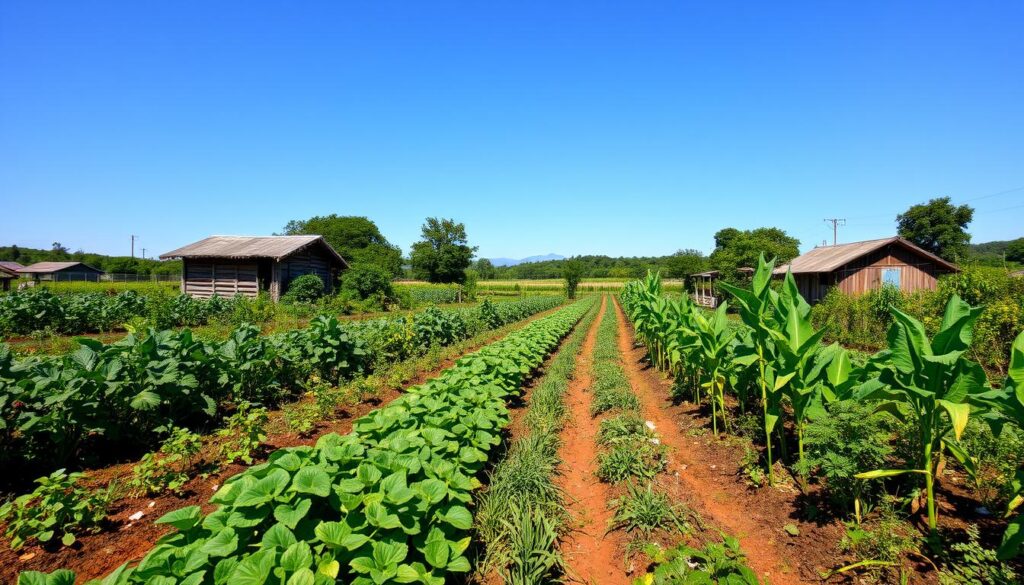
| Practice | Benefits |
|---|---|
| Agroforestry Integration | Promotes biodiversity, reduces soil erosion |
| Regenerative Agriculture | Regenerates soil health, promotes ecosystem services |
| Waste Management | Reduces waste and pollution, promotes sustainable agriculture |
Community Involvement and Education
Getting the community involved is key for permaculture projects to succeed. It shows how important it is to have permaculture resource recovery in local areas. By using regenerative design, communities can help each other. This way, they can build a circular economy that helps everyone.
There are many educational chances in permaculture, like:
- Learning organic farming techniques
- Water saving methods
- Composting
- Setting up renewable energy systems
These topics can improve community skills. They also encourage living in a sustainable way.
Working together with local groups, government, and schools can help permaculture projects a lot. When communities join forces, they can make a better, stronger system. This system will use permaculture resource recovery and regenerative design. It will help make a strong circular economy for everyone.
Assessment and Planning
Assessment and planning are key in permaculture. They help people make a system that’s good for the environment. By looking at resources and setting goals, they can find ways to use green technology and organic farming.
Understanding permanent land features is important. This includes things like climate, land shape, and water. By focusing on these, people can design gardens that are kind to the planet.
- Conducting resource surveys to identify areas for improvement
- Setting goals for resource recovery and implementing strategies to achieve them
- Prioritizing permanent land features in decision-making
- Implementing organic farming practices to promote environmental sustainability
| Factor | Importance |
|---|---|
| Climate | High |
| Landform | Medium |
| Water | High |
By following these steps and considering these factors, individuals can create a comprehensive assessment and planning strategy. This strategy promotes green technology and environmental sustainability in their permaculture system.
Case Studies of Successful Permaculture Systems
Permaculture is key to making systems sustainable and regenerative. It follows a circular economy model. This helps create systems that support biodiversity, save resources, and help local communities. The Urban Permaculture Project is a great example of this in action, showing how permaculture can thrive in cities.
The Urban Permaculture Project uses regenerative design. This means designing systems that work together. They promote biodiversity, save resources, and support local communities. Some key parts of this project include:
- Use of rainwater harvesting and greywater recycling to reduce water consumption
- Implementation of composting and mulching practices to improve soil health
- Creation of a diverse and thriving ecosystem, including a variety of plants and animals
The Agroforestry Success project is another success story. It shows how adding trees to farms can be beneficial. This method boosts biodiversity, improves soil, and can increase farmers’ income. By using permaculture, people can build sustainable systems that help communities and support a circular economy.
| Project | Location | Key Features |
|---|---|---|
| Urban Permaculture Project | Urban area | Rainwater harvesting, greywater recycling, composting, and mulching |
| Agroforestry Success | Rural area | Integration of trees into farming systems, promotion of biodiversity, and improvement of soil health |
Challenges in Resource Recovery
Effective waste management and eco-friendly practices are key for sustainable agriculture. Yet, several challenges make it hard to adopt these methods. Climate change, limited resources, and money issues are big hurdles for permaculture systems.
Some of the main challenges include:
- Climate change impacts: Rising temperatures and changing rain patterns hurt crop yields and water supply. It’s vital to use sustainable farming methods.
- Resource accessibility: Not having enough water, soil, and nutrients makes growing sustainable crops tough.
- Financial constraints: Starting sustainable practices can be expensive. This is a big problem for many farmers and individuals.
Despite these challenges, sustainable farming has many benefits. It reduces waste, improves soil, and boosts crop yields. By tackling these issues and using effective waste management and eco-friendly practices, we can support sustainable farming. This helps fight climate change.
| Challenge | Impact | Solution |
|---|---|---|
| Climate change | Rising temperatures, changing precipitation patterns | Implementing sustainable agriculture practices, using drought-resistant crops |
| Resource accessibility | Limited access to water, soil, and nutrients | Conserving water, using efficient irrigation systems, and promoting soil health |
| Financial constraints | High upfront costs for sustainable practices | Providing incentives, offering training and education, and promoting community involvement |
Future of Permaculture Resource Recovery
Looking ahead, permaculture resource recovery is key to a sustainable world. It uses regenerative design to help both people and the planet. This approach supports a circular economy.
Innovations, policies, and scaling up are crucial for success. Here’s how:
- Use permaculture resource recovery to cut waste and recycle more
- Back policies that boost regenerative design and circular economy
- Expand permaculture resource recovery efforts for bigger impacts
Innovations on the Horizon
New tech and methods are emerging for permaculture resource recovery and regenerative design. These advancements will foster a circular economy and a greener future.
Policy Implications and Support
Supportive policies are vital for permaculture resource recovery and regenerative design. They help build a circular economy. Together, we can achieve a sustainable world.
Scaling Up Practices
Expanding permaculture resource recovery efforts is crucial. By supporting these practices, we ensure a brighter future for all.
Conclusion: The Path Forward in Resource Recovery
The principles of permaculture show a bright way to recover resources and care for our planet. By using a circular economy and diverse, regenerative practices, we can make systems that last. This is key to keeping our natural resources from running out.
The future of environmental sustainability, organic farming, and soil health depends on us. We need to use these holistic solutions on a large scale. This will help us create a better world for all.
For those wanting to help, the way ahead is clear. We must educate, work together, and support policies that help. By doing this, we can make permaculture a big part of our lives. Together, we can create ecosystems that are healthy and self-sustaining.

